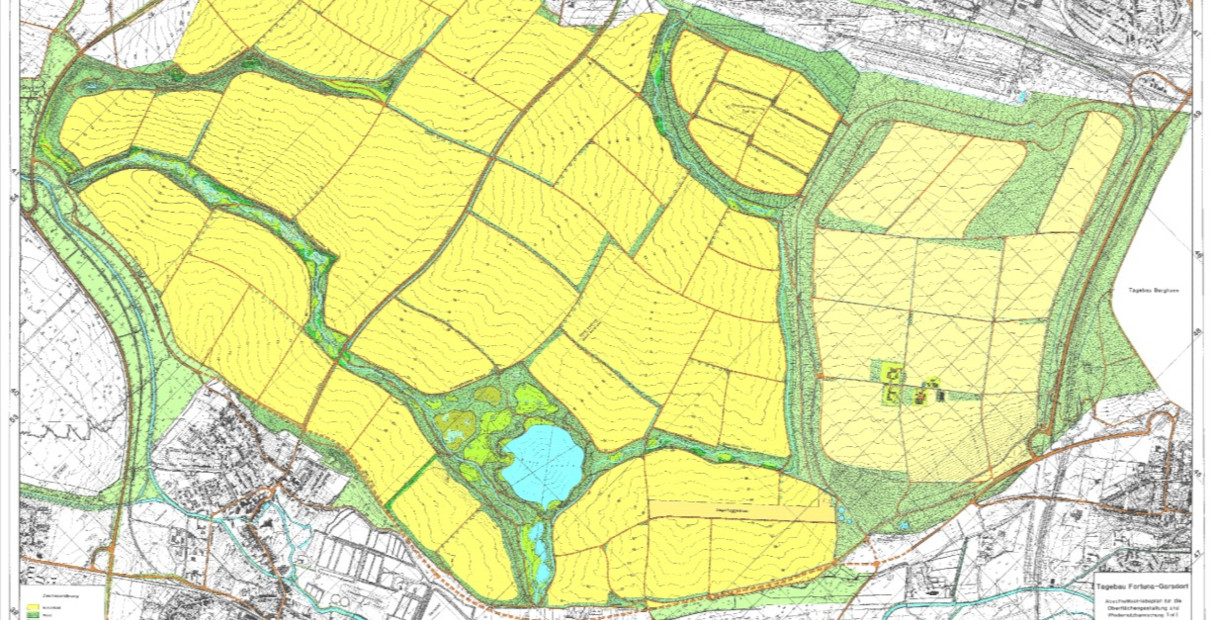
The history of recultivation
Recultivation in the Rhenish lignite area has a long tradition. Initial requirements and demands for recultivation date back far into the past. A lease agreement for the Roddergrube from the year 1766 already includes the requirement to reforest the pit with alders after the conclusion of mining. Rather than concerns about the landscape, let alone ecology, this was based on tangible economic reasons: The forest was an important asset.
A century later, Prussia’s general mining law (1865) expressly required an expert rehabilitation assessment. Here, the mining authority monitored all measures such as landscape design and use by mining operations after the mining of lignite.
Lignite mining grew to industrial proportions around the turn of the century. This meant an ever greater emphasis had to be placed on restoring the depleted areas to economic usefulness. In a ‘mining police directive’ from 1929, the State Supreme Office of Mining in Bonn stipulated that: ‘In opencast lignite mining, all overburden has to be replaced in the depleted opencast mine so that the areas usable for agriculture and forestry are maximised.’
Rehabilitation legitimately focused on establishing new forest areas until World War II. After all, lignite mining primarily took place in the forested Villerücken region between Bonn and Cologne at the time. Only when the opencast mines advanced northward into areas of the Lower Rhine Basin where farming predominates did the rehabilitation requirements change. This led to the loess accord in the 1960s, prescribing the use of fertile loess for recultivation.
Recultivation begins before opencast mining
The outlines of the post-mine landscape are established in the approval procedure for an opencast mine, before excavation begins, and a binding agreement is reached on the development endpoint – the return of an ecologically intact landscape. Concrete planning of the new landscape also begins at this time. Approval procedures under public law establish the framework for the future landscape design early on. The landscape that RWE Power has to leave behind after opencast mining is always decided by procedures under public law. Initial approval of an opencast mine by the state planning authorities includes a decision on the appearance and character of the subsequent new landscape.
The allocation of areas for agriculture, forestry, settlements and other uses is established. The opencast lignite mines are located in a cultivated landscape that has been used intensively since time immemorial. Since this is the catchment area of Cologne, Aachen, Mönchengladbach and Düsseldorf, it is quite densely populated. The soil is also among the best in Germany and therefore used mainly for agriculture.
Thus the goal is to create a sustainable, multifunctional landscape based on the previous uses and regional interests, meeting all usage requirements and taking nature conservation into account. To achieve this goal, the new landscape has to be considered in the planning process from the outset. The outlines of recultivation are therefore established in the planning procedure before ground is even broken for the development of an opencast mine.

Example of recultivation planning from start to finish.
Legal bases: Lignite plan
Mining law forms the basis for the extraction of raw materials. Permission for the operation of an opencast mine and for coal mining is issued with the approval of the lignite plan. A lignite plan is prepared under the auspices of the lignite committee, which includes representatives of all project stakeholders. Public and private interests are comprehensively weighed against and among each other during the planning procedure. Any citizen whose interests are affected by the project can express their concerns and make suggestions. A lignite planning procedure is a very elaborate process. It commonly takes ten or more years from the initial application until the lignite plan is approved. The lignite plan supersedes the regional plan during its term.
Rough planning for the post-mine landscape has to be established in the lignite plan. This provides municipalities and citizens as well as mine operators with long-term planning reliability and also makes it possible to plan the recultivation well in advance, ensuring results of high quality. Thus the initial recultivation plan exists before the opencast mine is developed.
Final operating plan
The final operating plan regulates the end of mining authority control for the recultivated areas. Only areas no longer under mining authority control can be returned to the public and dedicated to new uses. The final operating plans are intended to integrate the recultivated areas into the cultivated landscape. They are therefore based on the goals defined in the lignite plan by the state planning authorities. In addition to the technical details regarding the execution of recultivation, the final operating plan includes information about the landform configuration, land use types, river development, rural roads and recreational structures such as hiking trails and landscaping features.


